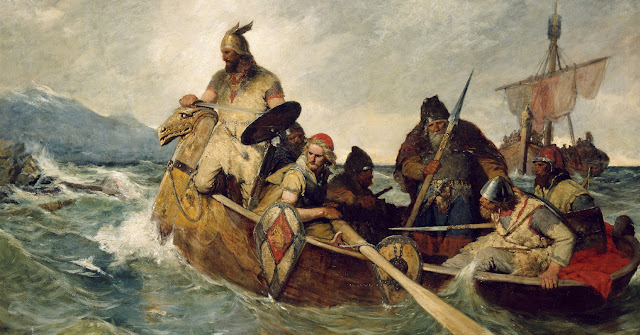Around 1015, Saint Olaf (King Olaf II Haraldsson) ended his career as a Viking and mercenary to proclaim himself ruler of Norway. His ascension ended fifteen years of foreign domination in Norway, as prior to Olaf’s appearance, the Norwegian jarls had been paying tribute to Denmark and Sweden. Therefore, Saint Olaf spent his inaugural year forcing the Norwegian jarls into submission or exile, and systematically rooted out foreign tax collectors from his lands. Yet, even after asserting Norway’s independence and gaining the title of king, Saint Olaf ‘s court was missing some final touches. It had been around fifteen years since Norway had last been ruled by its own king, and Olaf found the realm inadequately supplied with regal robes, rare pelts, fine tablecloths, and other such items that any self-respecting monarch might need. In order to obtain these goods, Saint Olaf was said to have partnered with a merchant by the name of Guthleik Gerzki, a prominent trader who knew his way around the Baltic Sea markets.
After forming a contract with Saint Olaf, Guthleik Gerzki set sail around 1016 to procure all the regalia and adornments that the Norwegian monarch desired. His first stop was the island of Gotland, but the merchant soon continued on his way, traveling across the sea and going inland to the trade hub of Holmgard, which is now called Novgorod. There, Guthleik Gerzki was able to find everything on his shopping list, so he began his return trip to Norway on a ship laden with robes, cloth and fur intended for Saint Olaf’s court.
Unfortunately for Guthleik Gerzki, he was living in the Viking Age, and the Baltic Sea was no less dangerous than the English Channel in regards to pirate raids. Furthermore, as Saint Olaf’s ascendance had annoyed the Danish and Swedish monarchs, Vikings were further incentivized to attack Norwegian ships, as they might be rewarded by their kings for damaging Saint Olaf’s interests. With this in mind, a certain Thorgaut Skardi, a Swede of uncertain rank, learned of Saint Olaf’s partnership with the merchant, and when he gathered this information, Thorgaut was determined not to let Guthleik Gerzki return to Norway. Through gossip and spies, Thorgaut was able to track down the merchant and intercepted him in the waters off the mainland of Sweden, presumably near the island of Öland. Guthleik was caught completely off guard by the attack, and he and his crew were quickly overpowered. Without much difficulty, Thorgaut slew Guthleik and stole the expensive cargo that was meant for Saint Olaf. After obtaining this loot, Thorgaut sailed back to Sweden, intending to give the best items of the haul to the Swedish king.
News of Guthleik Gerzki’s death, and the seizure of Saint Olaf’s goods, spread with incredible speed to Norway. The theft particularly infuriated a man named Eyvind Urarhorn, an able supporter of Saint Olaf who had a history of hunting down foreign tax collectors in Norway. As he was skilled at tracking foreign agents, Eyvind took it upon himself to recover his monarch’s stolen cargo. On his own initiative, he was said to have sailed to the island of Öland and there began tracking his prey along the coast of Sweden. As the story goes, Eyvind Urarhorn succeeded in intercepting Thorgaut Skardi before the pirate could reach the Swedish king. Eyvind reportedly killed Thorgaut, reclaimed the stolen cargo for Norway, and brought the merchandise back to Saint Olaf by the fall of 1017, finally uniting the king with his long-delayed royal robes, tablecloths and furs.
Written by C. Keith Hansley
Picture Attribution: (Norwegians landing in Iceland, painted by Oscar Wergeland (1844–1910), [Public Domain] via Creative Commons).
Sources:
- Heimskringla, by Snorri Sturluson and translated by Lee Hollander. Austin: University of Texas Press, 1964, 2018.

No comments:
Post a Comment